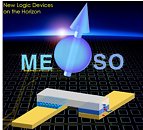- Joined
- Oct 9, 2007
- Messages
- 47,511 (7.48/day)
- Location
- Hyderabad, India
| System Name | RBMK-1000 |
|---|---|
| Processor | AMD Ryzen 7 5700G |
| Motherboard | ASUS ROG Strix B450-E Gaming |
| Cooling | DeepCool Gammax L240 V2 |
| Memory | 2x 8GB G.Skill Sniper X |
| Video Card(s) | Palit GeForce RTX 2080 SUPER GameRock |
| Storage | Western Digital Black NVMe 512GB |
| Display(s) | BenQ 1440p 60 Hz 27-inch |
| Case | Corsair Carbide 100R |
| Audio Device(s) | ASUS SupremeFX S1220A |
| Power Supply | Cooler Master MWE Gold 650W |
| Mouse | ASUS ROG Strix Impact |
| Keyboard | Gamdias Hermes E2 |
| Software | Windows 11 Pro |
Today, "Nature" published a research paper on the next generation of logic devices authored by researchers from Intel, the University of California, Berkeley, and the Lawrence Berkeley National Laboratory. The paper describes a magneto-electric spin-orbit (MESO) logic device, invented by Intel. MESO devices have the potential to lower voltage by 5 times and energy by 10-30 times when combined with ultralow sleep state power, as compared to today's complementary metal-oxide-semiconductors (CMOS). While Intel is pursuing CMOS scaling, the company has been working on computing logic options that will emerge in the next decade for the beyond-CMOS era, driving computing energy-efficiency and allowing performance to grow across diverse computing architectures.
"We are looking for revolutionary, not evolutionary, approaches for computing in the beyond-CMOS era. MESO is built around low-voltage interconnects and low-voltage magneto-electrics. It brings together quantum materials innovation with computing. We are excited about the progress we have made and are looking forward to future demonstrations of reducing the switching voltage even further toward its potential," said Ian Young, Intel Senior Fellow and director of the Exploratory Integrated Circuits group in the Technology and Manufacturing Group.

Intel researchers invented the MESO device, with the memory, interconnect and logic requirements of future computing needs in mind. The MESO device was prototyped at Intel using quantum materials with emergent quantum behaviors at room temperature, with magneto-electric materials developed by Ramamoorthy Ramesh at UC Berkeley and the Lawrence Berkeley National Laboratory. MESO also utilizes spin-orbit transduction effects described by Albert Fert at Unité Mixte de Physique CNRS/Thales.
"MESO is a device built with room temperature quantum materials," said Sasikanth Manipatruni, senior staff scientist and director of Intel Science and Technology Center on Functional Electronics Integration and Manufacturing. "It is an example of what is possible, and hopefully triggers innovation across industry, academia and the national labs. A number of critical materials and techniques are yet to be developed to allow the new type of computing devices and architectures."
The Nature publication can be accessed here.
View at TechPowerUp Main Site
"We are looking for revolutionary, not evolutionary, approaches for computing in the beyond-CMOS era. MESO is built around low-voltage interconnects and low-voltage magneto-electrics. It brings together quantum materials innovation with computing. We are excited about the progress we have made and are looking forward to future demonstrations of reducing the switching voltage even further toward its potential," said Ian Young, Intel Senior Fellow and director of the Exploratory Integrated Circuits group in the Technology and Manufacturing Group.

Intel researchers invented the MESO device, with the memory, interconnect and logic requirements of future computing needs in mind. The MESO device was prototyped at Intel using quantum materials with emergent quantum behaviors at room temperature, with magneto-electric materials developed by Ramamoorthy Ramesh at UC Berkeley and the Lawrence Berkeley National Laboratory. MESO also utilizes spin-orbit transduction effects described by Albert Fert at Unité Mixte de Physique CNRS/Thales.
"MESO is a device built with room temperature quantum materials," said Sasikanth Manipatruni, senior staff scientist and director of Intel Science and Technology Center on Functional Electronics Integration and Manufacturing. "It is an example of what is possible, and hopefully triggers innovation across industry, academia and the national labs. A number of critical materials and techniques are yet to be developed to allow the new type of computing devices and architectures."
The Nature publication can be accessed here.
View at TechPowerUp Main Site





